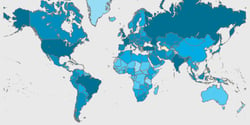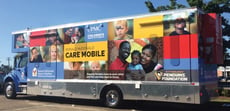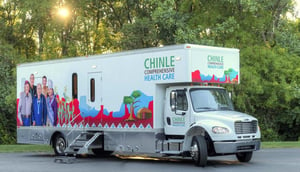With the need to expand accessibility and improve patient outcomes in much of the world, the healthcare infrastructure is rapidly changing its delivery model to put a renewed emphasis on mobile medical.
Due to the increase of chronic diseases and skyrocketing healthcare costs, the industry is experiencing unprecedented transformation. And because of the inequalities and social barriers to the delivery of healthcare in many countries and regions there is extreme disenfranchisement, resulting in numerous diseases disproportionately impacting large segments of many populations.
These inequalities demonstrate the crucial need to expand access to adequate care and reduce healthcare costs in order to improve the overall health of the United States and the world at large. The evidence is indisputable and validates the need for policymakers and health professionals to develop creative approaches that will provide early diagnoses and treatments of chronic diseases in a way that is sustainable. The spread of disease usually begins in urban and rural communities that lack appropriate access to care. That’s why mobile clinics are so valuable in reaching these population groups. As mobile medical concentrates on preventative and primary care and intervenes with at risk people, diagnosis and early intervention increases the probability of recovery. Ultimately this minimizes the potential of diseases spreading and greatly impacts a reduction in the cost of healthcare.
the need for policymakers and health professionals to develop creative approaches that will provide early diagnoses and treatments of chronic diseases in a way that is sustainable. The spread of disease usually begins in urban and rural communities that lack appropriate access to care. That’s why mobile clinics are so valuable in reaching these population groups. As mobile medical concentrates on preventative and primary care and intervenes with at risk people, diagnosis and early intervention increases the probability of recovery. Ultimately this minimizes the potential of diseases spreading and greatly impacts a reduction in the cost of healthcare.
Mobile medical clinics are a flexible and practical choice in overcoming deficiencies in the healthcare market. Regions with an inadequate health infrastructure are experiencing an increasing need for mobile clinics to provide services that are otherwise inaccessible to them.
A Pandemic’s Impact on the Mobile Medical Clinic Market
With the global occurrence of the COVID-19 pandemic, the post effect has created an increased demand for mobile units. Initially in 2020 as the disease created a social lockdown, many mobile programs were shuttered due to an inability to social distance inside an mobile unit. However, the interruption of services forced many providers to adapt their units with special air quality systems and more efficient barriers to distance patients. Many operators of mobile medical clinics realigned their objectives for COVID diagnostics and screening purposes to cover as much of the population as possible. Then as vaccinations for the disease became available in early 2021 many mobile units were put back on the road to inoculate much of the rural and urban populations who were unable or too apprehensive to go to public locations.
The impact of the recent pandemic and increases in chronic diseases that are becoming more prevalent in rural and remote areas has contributed to organizations such as the CDC and WHO to explore alternative healthcare delivery models. The likelihood of federal health screening mandates and the increasing need for chronic disease management in rural areas is significantly impacting the demand for mobile medical clinics.
Don’t Be Left Behind
The increase in demand to provide brick and mortar healthcare facilities in rural areas is usually not economically feasible and has therefore boosted a demand for mobile clinics. Mobile health clinics travel to these areas and are manufactured for or otherwise adapted to provide a wide variety of services, including:
| Health screenings, checkups & treatments | Testing and inoculation for serious diseases |
| Mammography/Breast cancer screenings | Behavioral health & addiction services |
| Dental check-ups and procedures | Maternal health clinics |
| Mobile laboratories | Mobile simulation labs |
| Bloodmobiles | And many other services |
The average mobile medical clinic sees 3,250 patients per year, providing a consistent revenue stream for the parent organization. This does not include the residual patient referrals to the home facility, which ultimately results in an  increase of annual patient visits and exponential growth in revenue.
increase of annual patient visits and exponential growth in revenue.
According to Future Market Insights, of the various clinic types OPD (Out-Patient Department) mobile clinics provide the highest revenue generation for the parent organization. These mobile medical units deliver the widest variety of medical care. The second most profitable are diagnostic/screening units, with maternal health mobile clinics expected to experience significant growth over the next ten years due to a growing increase in awareness.
Major manufacturers of mobile clinics include:)
| ADI Mobile Health Inc. | LifeLine Mobile, Inc. | Kentucky Trailer Technologies |
La Boit Specialty Vehicles Inc.
|
| Medical Coaches Inc. | Odulair LLC | Farber Specialty Vehicles |
Matthews Specialty Vehicles Inc.
|
How Mobile Clinics Help Meet the Need
Mobile clinics remove many of the logistical challenges to conventional types of healthcare delivery by being visible and accessible to the public. They help mitigate issues that many people struggle with, such as appointment scheduling, transportation, waiting rooms and complicated administrative procedures that many find too daunting to cope with. Quantitative data from numerous sources has shown that mobile medical is successful in helping patients overcome these challenges.
Though many mobile clinics are built for one modality, such as dental or mammography, depending on the manufacturer they can be modified to meet other specific needs for emergency situations such as a pandemic. They have proven to be a highly efficient setting for chronic disease treatment by helping clients maintain adherence to required drug therapy and lifestyle changes. Mobile units provide considerable advantages to the healthcare system with early initiation of patient treatment, ultimately reducing costs to the system. They decrease emergency room visits and hospital admissions, improve the patient’s ability to self-manage their conditions, and enhance patient quality of life.
Conclusion
The healthcare industry is moving to an emphasis of better and more unified health management of the global population and mobile health clinics are projected to play a major role in this effort. For instance, Native Americans often live hours away from the nearest hospital. And in many countries, such as Spain, there is no national policy regarding small hospitals and emergency services in rural areas. Instead, hospitals are classified according to their clinical purpose, not their size or location.
clinical purpose, not their size or location.
The World Health Organization and its many partners regularly deploy mobile health clinics to reach people cut off from access to health services. For a large segment of the population mobile clinics may be the only source of health care. According to the WHO, “mobile clinics offer flexible and viable options for treating isolated and vulnerable groups as well as to newly displaced populations. The demand for mobile units keeps rising. WHO may buy mobile clinics or supply them or pay for partners to buy or supply them.” The World Health Organization is a specialized agency of the United Nations responsible for international public health. The organization’s Constitution, which establishes the agency's governing structure and principles, states its main objective is "the attainment by all peoples of the highest possible level of health." Clearly, even the World Health Organization, with its mandate to ensure a healthier world population believes in the growing necessity of mobile medical clinics. To help shore up a struggling healthcare system and increase revenue for their organizations, it’s time for more private and public institutions to consider mobile health as an instrumental part of their business.
Additional Sources Include:


